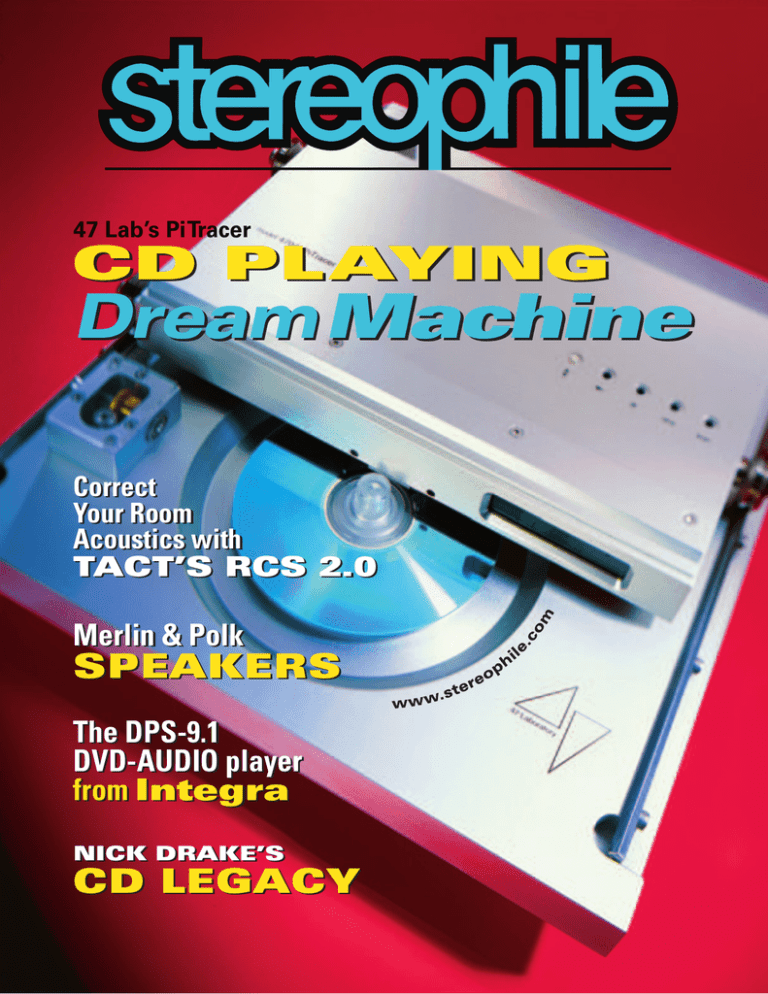
47 Lab’s PiTracer
CD PL AYING
Dream Machine
Correct
Your Room
Acoustics with
TACT’S RCS 2.0
Merlin & Polk
SPEAKERS
The DPS-9.1
DVD-AUDIO player
from Integra
NICK DRAKE’S
CD LEGACY
Equipment Report
Jonathan Scull
47 Laboratory 4704 PiTracer CD transport
E
very once in a while, a piece of
super-esoteric gear crosses my
path that, on the face of it, makes
no sense whatsoever. Eventually, however, the component is revealed as being
“merely” simple and elegant, begging
the question: Must it always be done the
way it’s always been done?
The 47 Lab’s 4704 PiTracer CD transport is such a product. The French, who I
think are close in some ways to the
Japanese in their design aesthetic, would
certainly call the PiTracer une grande follie.
Anyone might be forgiven for thinking
so — the PiTracer is bizarre at first glance.
But the logic behind the PiTracer is
impeccable. What’s called for, after all, is
to rotate a CD at a constantly diminishing speed as the lens tracks from the
inside to the outside of the informationcarrying layer, while keeping the laser
focused on the pit spiral burned in the
polycarbonate so that the ones and zeros
are faithfully retrieved. The PiTracer
does precisely that, and in a most original
and unusual way.
Pedigree
The PiTracer, we are told, is the result of
twelve years of R&D by one Mr. Junji
Kimura. According to www.sakura
systems.com, “This machine is the reason
he established 47 Laboratory in 1992.”
The web article goes on to speak of
Kimura’s journey so far, which includes
his Gaincard amplifier (to be reviewed
by Robert Deutsch in a future issue),
Flatfish CD transport, and other prod-
Specification: CD and CD-R Transport. Digital data outputs: two pairs
S/PDIF on RCAs (one DC-coupled,
one AC-coupled), two pairs S/PDIF
on BNCs (one DC-coupled, one ACcoupled).
Dimensions: 4704 PiTracer; 14.2"
(360mm) W by 4.1" (105mm) H by
12.6" (320mm) D. Weight: 24 lbs.
4700 Power Humpty power supply;
7.7" (130mm) H by 5.1" (195mm)
diameter (cylindrical). Weight: 10 lbs.
Price: $25,000, 4704 PiTracer; $1800,
ucts. You can also read of his unending
audio quest: “at the core of his creative
activity was the PiTracer.”
According to Yoshi Segoshi of US
importer Sakura Systems, everyone
waited with bated breath for Mr. Kimura’s nod on the PiTracer, while several
prototypes were made and rejected.
“But now, the dream machine is finally
here!”
Let’s take a gander . . .
The PiTracer is built on the Platform, a
base plinth almost the size of an LP, if
rather deeper, and machined from solid
aluminum. Dominating the front section is the nice-looking, solid-acrylic CD
turntable with its lightweight, translucent, screw-down clamp. Each of
the PiTracer’s rear corners has a skinny
aluminum footer to provide a stable base.
The Platform supports the spindle
motor and contacts the shelf below with
a mechanical ground that tapers to a
point. It’s the audiophile equivalent of
Falling Water, that wonderful home
designed by Frank Lloyd Wright and
built over a Pennsylvania waterfall.
If you grunt and bend to peer
beneath the Platform, you’ll see another
motor housing to the left, close to the
front, also coupled to the stand by a
point. Its spindle pops up through the
Platform and connects to the laser sled
via a worm gear — the motor head/
worm gear assembly is visible through a
clear-topped aluminum casing. You can
see, all too graphically, the motor correct-
Humpty.
Finishes: “Silver Hairline,” black
anodized.
Approximate number of dealers:
16.
Serial numbers of units reviewed:
None visible.
Manufacturer: 47 Laboratory, Japan.
US distributor: Sakura Systems, 2
Rocky Mt. Rd., Jefferson, MA 01522.
Tel./Fax: (508) 829-3426. E-mail:
sakurastms@aol.com. Web: www.
sakurasystems.com
ing like mad for off-center CDs. In fact,
it’s amazing just how much off-center
most CDs are, which is why the CD
system is built around heavy feedback
servo systems to deal with the problem.
Like a spaceship from 2001: A Space
Odyssey looming over the platform — I
can almost see the astronauts in the control room — not just the laser pickup
but the entire sled makes its way from a
CD’s beginning, or inner “groove,” and
tracks back out to the end of the pit spiral, at the outside edge of the polycarbonate disc.
The sled is carried on two wheels on
the left side (looking from the front)
and a single wheel on the right, running
on stainless-steel knife-edge rails and
deeply grooved wheels. (Curiously, the
rails are made in America, their manufacturer’s name and location stamped
proudly upon them: Bishop-Wisecarver,
Pittsburg, California!)
The heart of the transport is the intricately wound and spring-loaded Thread
Drive Mechanism, which controls the
actual back-and-forth movements of the
sled. The thread has a Kevlar core and a
polyethylene jacket, and winds its way
from the worm-gear drive up front via a
bearing to a small locating stud on the
lower front vertical edge of the sled
behind the front wheel, then runs past
the rear wheel all the way back to the
rear of the platform, U-turns there on an
aluminum post/bearing, and heads back
for the sled. There it wraps around
another locator stud, rises up and over
the rear wheel to another stud/locator,
then runs forward about half the distance of the sled, at which point the
thread is tied to a small, high-tension
spring that’s attached to the sled.
Segoshi explained that, via the worm
gear linked to the drive motor, the motor
moves the sled with a minimum of servo
assist from the laser assembly. The information regarding the off-centeredness of
any particular CD is fed to the servo,
which in turn adjusts the movement of
the motor, thus the sled — not just the
laser pickup, as is usually the case. Thus,
the angling movements required of a
typical laser assembly are minimized,
ERIC SWANSON
and the laser is always at a healthy 90°
angle to the pit information. Neat.
The two motors themselves are anything but pedestrian. They’re directdrive, “with a highly sensitive, low-inertia,
high-torque coreless motor with a spindle diameter of 3mm.” The spindle and
sled motors are driven by four op-amps
of the same grade found in 47 Lab’s
4706 Gaincard amp, and control. “With
the combination of this simple mechanism, we have realized smooth and
quick analog management.” Interesting
way to put it.
When clamped down to the turntable — two-and-a-half twists of the
wrist, and don’t make it too tight — the
CD is supported at its inside and outside
edges only, thus “minimizing the effect
of the turntable material and any possible overdamping that may occur.” I
think that’s a very clever idea, and a
good way to flatten out the CD.
But man, is there a lot of sled movement required to keep the laser in the
pits. Watching the PiTracer’s quickreacting, high-torque, coreless motor
shimmying wildly as it moved the sled
back and forth to keep the information
under the optics — even with the CD
held flat — gave this astounded user a
good idea of just how big a problem it is.
The laser assembly in a conventional
player does a lot of gymnastics to bring
you your music, but you just don’t see it.
The sled mechanism is machined
from aluminum block. The pickup
optics are sourced from C.E.C., says the
manual, and control buttons on the top
panel can be used in conjunction with
the remote to control the sled’s movements. In fact, the top-panel buttons are a
bit odd. (No kidding, he thought to himself.) Toward the center is a white button
marked with arrows pointing both ways.
(I thought you couldn’t have it both
ways!) If pressed deeply, it moves the sled
all the way back, where it holds position.
If pressed about halfway down, it moves
forward, almost to the spindle, reads the
disc’s Table of Contents, then glides back
slightly to track 1 and waits for instructions. (I understand that the remote control’s operation and cosmetics are being
upgraded; I found it adequate to its tasks.)
The next button is Play. After you’ve
loaded and clamped the CD, just tap
this one and the PiTracer does the rest.
Next to Play is Pause, with two track
forward/track back buttons next to that.
Facing the user is an LCD display
that’s one of the worst I’ve seen on a
high-end product in all my experience
as a reviewer. For 25 grand, this is what
47 Laboratory gives its customers for
track information? Very cheesy. The
entire row the big, fat lo-rez pixels are
active on becomes visible, as if the contrast had been turned up too high. Sorry
if I’m causing any loss of face, KimuraSan. I have been assured, however, by importer Segoshi that a better display is in
the works and will debut shortly.
Two wires run out from beneath the
sled. One is for the motor drive, the
other for the pickup circuitry. You can
run the PiTracer with one of 47 Lab’s
cylindrical 4700 Power Humptys, or
use a second Humpty to run the two
sections separately. You know me — I
used two, and yes, there was an
improvement in sound. The Humptys
are extra, by the way: $1800 each.
Setup
I pulled the heavy Accuphase DP-100
transport off its Bright Star Air Mass and
sand-filled Big Rock stands atop the
PolyCrystal rack and replaced it with the
PiTracer. Although I leveled the transport, it still moved the air stand a bit as
the sled moved around over the platform. No matter — there was plenty of
isolation from the environment. I ran
XLO The Limited RCA digital cable to
the Purcell D/D converter, connected to
the Elgar Plus D/A via another pair of
XLO The Limited for dual-AES operation (required for 24/192 conversion).
On the PiTRacer’s rear panel are two
pairs of S/PDIF data output connectors: two on RCAs and two on BNCs.
One of each pair is DC-coupled, the
other AC-coupled. (AES/EBU output
via an XLR is an option.) The outputs
aren’t labeled, and at first the dCS
Purcell D/D converter couldn’t lock on
the signal. Changing to the PiTracer’s
other RCA output connector solved
the problem. The dCS gear is apparently
very sensitive to voltage transients as a
matter of course — and, I suppose, to
DC as well.
I had great results with the Lamm L2
preamplifier, but listening to the PiTracer into the Purcell/Elgar Plus directly
into the Krell FPB 350Mc monoblocks
was utterly fantastic. Comparisons with
the $12,995 Accuphase CD/SACD
transport or the $20,000 Linn CD12
was cumbersome running direct, but
wahoo, what great sound….
Final auditioning was with the L2
and the 350Mc monoblocks or Cary
V12 stereo amp, rotating around the
other players and DACs that I had available. As great as the big Krells were, the
Cary sounded alarmingly fine in this
setup. Alas, the low 10k-ohm input
impedance of the Linn Solo 500 Klimax
monoblocks limited them to partnering
the Mark Levinson No.32 Reference.
Which I also tried. Which was another
sonic gas.
I paid special attention to both
Humpty power supplies. All digital
components were plugged into a PS
Audio Power Plant 300, itself plugged
into one side of a Power Plant 600. (I
use the other side for analog components.) To get the two Power Humptys
into this all-digital power struggle, I
plugged ’em both into a star-wired
power extender, the Ensemble Power
Point, which in turn was plugged into
the ’300.
Other power cords included the Synergistic Research products I’ve been
using for quite some time now, plus three
new entrants: the FIM High Definition
Music Conductor, the Coincident CST,
and the Audience PowerChord. The
huge, stiff FIM cords worked wonders
on both Humptys into the Power Point; I
used them for most of the review.
A Cardas-sourced star-wired extender
powered the Krells from one of our separate runs of 30-amp metal-jacketed
copper house wiring, back to a separate
breaker in the box with nothing else on
the line. We have dual-quad outlets on
this line, and an equal length of slightly
smaller-gauge, metal-jacketed copper
wires in a separate conduit running back
to another high-quality breaker in the
box, also unused by any other socket
and sprouting the same dual-quad, hospital-grade outlet setup as the amp side,
and good for 20 amps. (I never tire of
telling the story of K-10 pulling both
lines of cable through the roof/ceiling
crawlspace.) All duplex sockets are
grounded nicely to a cold-water pipe,
and there’s no plastic coupler from the
building’s water supply to the street
mains. Lots of local businesses pull the
electricity down during the day and
spike it good, but we run a happy and
stable 117V in the evenings, 118–120V
on weekends.
PiTracing
Could this baby ever sing.
My immediate impression of the
PiTracer, later backed up by many
hours of contented listening, was of
sonic clarity. It was so transparent that I
simply loved listening to music with it.
The extra-wide, -deep, practically
Olympic-sized soundstage made me
want to dive in!
I’ve heard this kind of presentation so
far only from SACD: The backgrounds
were blacker than black, resulting in an
enhanced sense of imaging. And running
47 L a b o r a t o r y 470 4 P i Tr a c e r
direct from the Elgar Plus to the Krells
gave me more of that special ease I crave,
and which I associate with high-bit-rate,
high-sampling-rate machines.
The PiTracer sounded very linear
from the bottom: stygian depths to the
highest of highs. Sweet, detailed, and
oh-so-right there — the immediacy made
me gasp with pleasure. Very much like
the Linn’s presentation — pacey, taut,
transparent, and fast off the mark.
I was surprised. I’d assumed that,
with so much processing going on in
the following stages, the contribution
of the transport to the overall sound
of today’s separate digital components
was becoming less significant. Was I
ever wrong!
Let’s start with some stylish new
music: the French band Air’s new
10,000Hz Legend (my sample, bought at
La Fnac in Paris, is Source 8 10332 2; it’s
available on the Astralwerks’ label in the
US). Track 1, “Electronic Performers,”
sets the stage for listening to this album:
A terrific driving bass line about a
minute and a half in leads to less, not
more, wall-of-sound histrionics, so stay
with it. The male vocal that enters 30
seconds later from the center of the
soundstage sounded to me like a genie
coming out of a bottle — sound fine
enough to be sipped and savored by
audiophiles everywhere.
Track 2, “How Does It Make You
Feel?,” is a love song voiced like a Mac
computer. It starts out rather maudlin,
then, suddenly, at 1:20, you’re in Sgt.
Pepperland! How’d the Beatles get in
here?! Then you’re jerked back to the
present. The musical references are
eclectic and very Soylent Green. The song
ends with a hysterical twist: The music
stops, and a male voice croaks, “So how
does this make you feel?” After a
moment of silence a processed female
voice replies, “Well, I really think you
should quit smoking.” But that’s so it!
The atmosphere was perfectly created,
the sonic clarity tremendous, the bass
tremendous, and the midrange was to
die for, with magnificent highs.
There’s something about the sixth
tracks of CDs — they’re invariably my
favorites. On 10,000Hz Legend, it’s
“Lucky and Unhappy’’ — a great piece
of music and very “audiophile.” If it
doesn’t sound utterly fantastic — you
don’t even have to open a zipper to step
into the large, tent-like acoustic set up
in front of and around your speakers —
then you need to check out “Fine
Tunes” at www.stereophile.com (“Archives” section) and get hip!
“Don’t Be Light” on this CD is aimed
right at all of you aging-rockers-at-heart
still secretly in love with Joan Jett and
who think that, yeah, it’s only rock’n’roll,
and I like it! It’s also a great track for revealing a system’s speed and coherence. On
the PiTracer it sounded clean, glistening,
and appealing in the midrange, with tight
transitions through an attractive upper
midrange and treble over very deep bass.
Plus the recording was as sweet as hell in
the highs via the PiTracer, no doubt aided
and abetted by the Krell 350MCs, which
I’ve come to regard as extremely powerful but fundamentally sweet-sounding
amps. Who’da thunk it?
Associated Equipment
Digital sources: Accuphase DP100 SACD/CD transport and DC101 DAC, dCS 972 and Purcell
D/D converters, dCS Elgar Plus
D/A converter, Linn Sondek CD12
CD player.
Preamplifiers: Lamm L2, Mark
Levinson No.32 Reference.
Power amplifiers: Cary V12, Krell
FPB 350MC monoblocks, Forsell
Statement.
Loudspeakers: JMlab Utopia.
Cables: Digital: XLO The Limited,
RCA and AES/EBU. Interconnect:
Synergistic Research Designer’s
Reference with Discrete and Active
Shielding, Cardas Golden Reference.
Speaker: AudioQuest Everest, Cardas
Golden Cross, XLO the Limited.
AC: PS Audio Lab Cable, Synergistic
Research Designer’s Reference Master Couplers2 and Point V, Coincident CST, Audience PowerChord.
Power extenders: Cardas, Ensemble
Power Point.
Accessories: ASC Studio Traps,
Argent RoomLenses, API Ultra
Enhancers, PS Audio P300 and P600
Power Plants with MultiWave upgrade, AudioPrism Quiet Lines, Signal Guard platforms, Silent Running
VR series platforms and isoDomes,
Black Diamond Racing shelves and
cones, DH Labs cones and Squares,
Nordost Pulsar Points, Bright Star
Air Mass and Big Rock combo, and
PolyCrystal amp stand, equipment
racks, cones, and cable towers.
— Jonathan Scull
Whenever the PiTracer was in the
system, vocals were finely drawn and
tightly focused, with just the right
level of chestiness for the boys and
perfect, lit-from-within sweetness for
the girls. Everything sounded flat as
can be frequency-wise, no particular
part of the audio spectrum exaggerated
or pumped. Transitions from the bass
and up through the mids sounded
seamless.
Listening to Peter Epstein + Scott Colley + Peter Erskine (M•A Recordings
M058A), I was struck by the PiTracer’s
rendering of cymbals and other highfrequency instruments: magnificent and
sparkly, dying out in a perfectly acoustic
way, with air, dynamics, and impact as
fine as I’ve ever heard. That includes
hearing this disc on the Forsell Air Bearing CD transport and the Accuphase
DP-100 — if not the Linn Sondek
CD12, which still gets the award for
dynamics and speed, even though it’s a
player, not just a transport.
An Accuphase moment
Until this point, all of my listening had
been to the PiTracer into the Purcell/
Elgar Plus: sometimes direct to the
amps, sometimes not. Feeding the
’Tracer driving to the Accuphase DC101 DAC, with its sextet of 24bit/192kHz–capable MASH converters
doing industry-standard 8x oversampling (not upsampling, as dCS would
have it) into the Lamm L2 preamp, I
found that while I appreciated the
Accuphase DC-101 at 16/44.1, I appreciated more the way the Purcell/Elgar
Plus did it — and by a country mile. I’m
not talkin’ SACDs here — just “Red
Book” CDs. But when I wired the
Accuphase DP-100 into the Purcell/
Elgar Plus and upsampled to 24/192,
the SACD transport sounded just as
great as I’ve been telling you — a touch
more round, warm, and sexy, not quite
as clear and fast. I thought I’d miss the
PiTracer’s clarity more, but the DP-100
ain’t chopped liver!
PiTracer for you, Sir?
So who’s the PiTracer for? Who’s
gonna plunk down 25 big ones plus
another $1800 per Humpty power
supply, and why? Well, you’re rich,
that’s for sure, so you can have pretty
much what you like. You like intricate, unique, sculptural forms around
you. You also have a huge collection
of CDs. Dang it all, you want the best
there is, and you can afford it.
Well, here it is, in black or silver!
s
Enjoy . . . .
Posted with permission from the September 2001 issue of Stereophile ®
Copyright 2003, PRIMEDIA Inc. All rights reserved.
For more information about reprints from Stereophile, contact Wright’s Reprints at 877-652-5295



